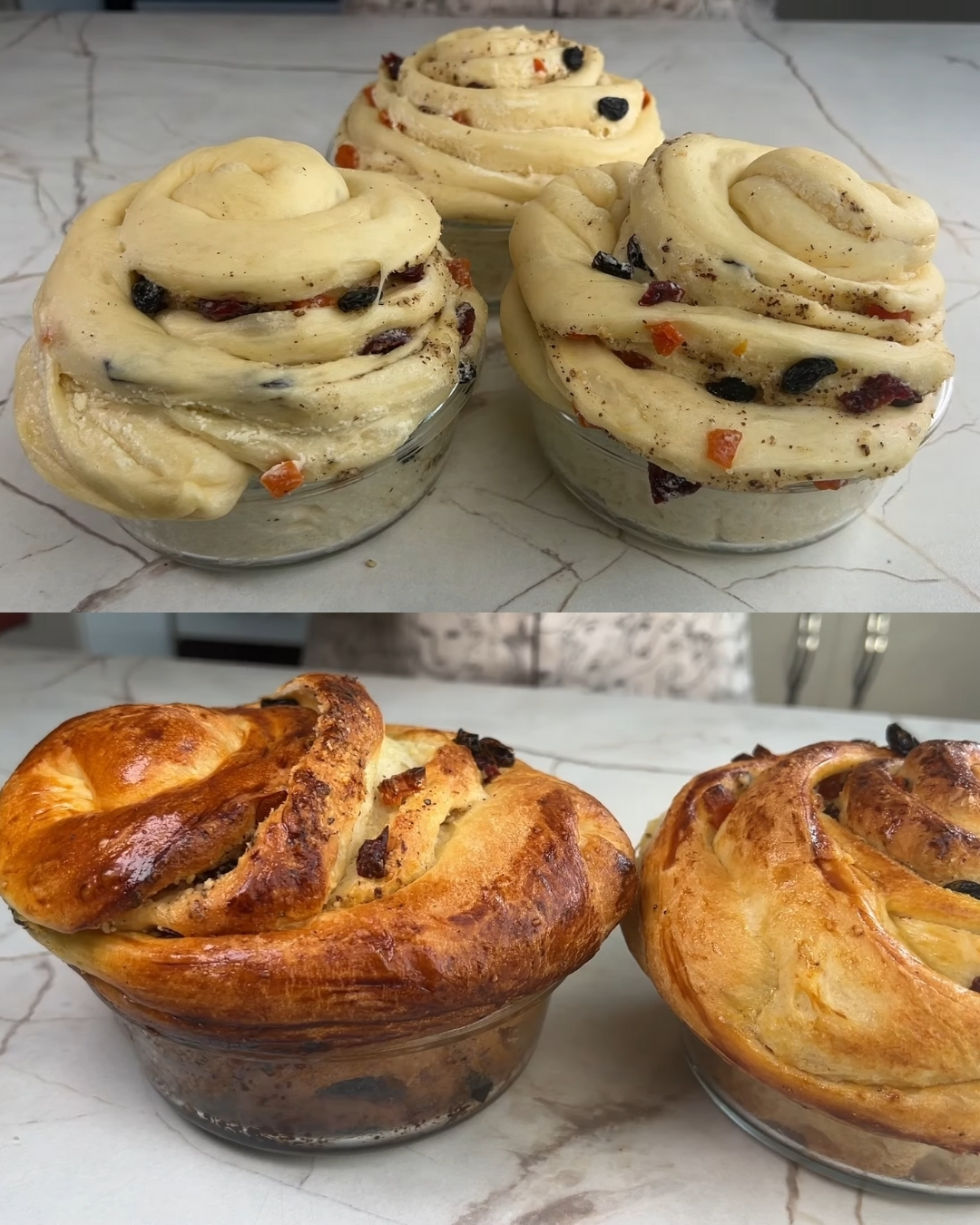There is something irresistibly nostalgic about the aroma of sweet, yeasted dough rising in a warm kitchen, its buttery perfume swirling with hints of vanilla, caramelised sugar, and dried fruit. Festive Apricot-Raisin Walnut Milk Bread takes that comforting memory and elevates it with a treasury of jewel-coloured cranberries, black raisins, tangy chopped apricots, and crunchy walnuts. The loaf marries the tender crumb of a classic milk bread with the richness of a brioche and the fruit-studded charm of a holiday stollen—yet it is straightforward enough for any weekend baker. Whether you slice it thick and toast it for breakfast, cube it for a decadent bread-and-butter pudding, or give it away as a handmade gift, this recipe delivers an occasion-worthy treat that still feels humble and homely.
Cooking Time
-
Prep (hands-on) 20 minutes
-
First rise 60–90 minutes
-
Shape + second rise 35–45 minutes
-
Bake 30–35 minutes
-
Cooling 60 minutes
-
Total ~3¼ hours (largely unattended)
Ingredients
Dough
-
200 ml lukewarm milk (about 38 °C / 100 °F)
-
100 ml lukewarm water (about 38 °C / 100 °F)
-
4 Tbsp (50 g) granulated sugar
-
1 Tbsp (9 g) active-dry yeast
-
60 g unsalted butter, melted and cooled to lukewarm
-
¼ cup (60 ml) neutral vegetable oil
-
2 large eggs, room temperature
-
550 g bread or all-purpose flour
-
1 tsp (6 g) fine sea salt
Fruit-and-Nut Mix (about 1 cup total; adjust to taste)
-
½ cup chopped dried apricots
-
¼ cup black raisins
-
¼ cup dried cranberries
-
¼ cup chopped walnuts
Finishing
-
2 Tbsp melted butter (for brushing)
-
2 Tbsp coarse or granulated sugar (for sprinkling)
Step-by-Step Cooking Directions
-
Bloom the Yeast Combine lukewarm milk, lukewarm water, and sugar in a large mixing bowl. Sprinkle in the active-dry yeast. Stir once, then allow to stand 5–8 minutes until the surface is frothy.
-
Build the Wet Base Whisk in melted butter, vegetable oil, and eggs until the mixture is homogenous and slightly creamy.
-
Form the Dough Add 350 g of the flour plus the salt; stir with a wooden spoon or dough whisk until a shaggy dough forms. Add remaining flour, 50 g at a time, until the dough pulls away from the bowl sides.
-
Knead Turn out onto a lightly floured counter and knead 8–10 minutes. The dough should feel soft, supple, and only tacky—not sticky. If needed, dust with a teaspoon of extra flour at a time.
-
Incorporate Fruit & Nuts Flatten the dough into a rough rectangle. Scatter the apricots, raisins, cranberries, and walnuts evenly. Roll up like a jelly roll, then knead gently just until the inclusions are dispersed. Over-kneading after the fruit goes in can tear the gluten.
-
First Rise Place the dough in a greased bowl, turn once to coat, cover with a damp towel or plastic wrap, and let rise in a warm, draft-free spot until doubled, 60–90 minutes.
-
Shape Punch down to release gas. For a classic sandwich loaf, roll the dough into a tight log and place seam-side down in a greased 9 × 5-inch (23 × 13 cm) loaf pan. For a festive crown, divide into three equal ropes and braid, then coil into a greased 9-inch (23 cm) spring-form pan.
-
Second Rise Cover and let the shaped dough rise 35–45 minutes, or until it crests 1 cm above the pan rim or looks puffy and light. Meanwhile pre-heat the oven to 180 °C / 350 °F.
-
Bake Brush the top lightly with milk if you prefer a soft crust. Bake 30–35 minutes, tenting with foil after 20 minutes if deep browning occurs. The loaf is done when the internal temperature reaches 93 °C / 200 °F or it sounds hollow when tapped.
-
Finish While still hot, brush with melted butter and sprinkle with granulated sugar for a subtle crunch. Cool in the pan 10 minutes, then unmould onto a rack. Let cool at least 1 hour before slicing to avoid a gummy crumb.
Nutritional Information (per 1 cm slice; loaf yields ~14 slices)
Calories 210 Protein 5 g Fat 7 g (Sat 3 g) Carbs 33 g Fiber 2 g Sugars 10 g Sodium 140 mg
Calculated with bread flour and full quantity of fruit; actual values vary.
Origins and Popularity of the Recipe
Enriched festival loaves date back centuries. In Germany, hefezopf weaves dried fruit and butter into braided celebratory breads; Italian panettone and Czech vanocka embody similar traditions. This recipe borrows the soft milk-bread method popularised in mid-20th-century Japanese bakeries and merges it with the fruit-and-nut exuberance of European holiday loaves. The result suits modern palates seeking plush texture without the weeks-long fermentation of classic stollen yet still delivers nostalgic seasonal flavours. Social-media bakers now share “milk bread with mix-ins” videos by the thousand, proof that tender crumb plus colourful fruit never goes out of style.
Reasons Why You’ll Love the Recipe
-
Fool-Proof Tenderness Milk, eggs, and butter guarantee a cloudlike crumb even for novice bakers.
-
Customisable Filling Swap walnuts for pecans, cranberries for cherries, or add chocolate chips—your loaf, your rules.
-
Keeps Moist for Days The high hydration and fat content slow staling; slices remain soft without preservatives.
-
Multi-Purpose Breakfast toast, French-toast base, bread-pudding hero, or holiday-ham sandwich canvas.
-
Gift-Worthy One recipe makes a shareable 900 g loaf; wrap in parchment and ribbon for an artisanal present.
Health Benefits
-
Dried Fruit Goodness Cranberries bring polyphenol antioxidants; raisins supply iron and potassium.
-
Walnut Omega-3s Just a handful provides alpha-linolenic acid, linked to heart health.
-
Homemade Control Less sodium and no artificial preservatives compared with supermarket fruit loaves.
-
Energy + Satiety Balanced macros—complex carbs for steady fuel, protein for repair, healthy fats for fullness.
Serving Suggestions
Toast & Toppers Spread with salted butter, mascarpone, or citrus marmalade.
Brunch Star Cube and bake into a rum-raisin bread-pudding.
Cheese Board Pair thin slices with aged cheddar, blue cheese, and honey.
Holiday French Toast Dip overnight slices in eggnog custard, griddle, dust with cinnamon sugar.
On-the-Go Slather peanut butter between two slices for a fruit-and-nut PB&J upgrade.
Common Mistakes to Avoid
-
Scalding the Yeast Milk hotter than 43 °C / 110 °F can kill yeast; always lukewarm.
-
Skipping Salt Salt not only flavours the crumb but also moderates yeast activity; omitting it yields a flat-tasting, loose loaf.
-
Adding Fruit Too Early Mix-ins during initial knead tear gluten; fold them after the dough is developed.
-
Under-Proofing Second Rise A tight crumb and burst crust result; wait until dough looks marshmallow-soft.
-
Cutting While Hot Steam escapes, leaving a gummy interior; patience rewards with perfect slices.
Pairing Recommendations
Beverages Spiced chai latte, medium-bodied Merlot, tawny port, or cold-brew coffee.
Meals Serve beside roast turkey, hearty soups, or autumnal salads with goat cheese and pears.
Desserts Turn leftover heel slices into a trifle layered with custard and fresh berries.
Cooking Tips
-
Fruit Prep Dust soaked, patted-dry fruit with 1 tsp flour before folding in; this helps suspend pieces evenly.
-
Egg Warm-Up Submerge fridge-cold eggs in warm water 5 minutes for better dough emulsification.
-
Window-Pane Test Stretch a walnut-sized dough piece; if it forms a translucent sheet without tearing, gluten is ready.
-
Steam Burst Place a small tray of boiling water on the oven floor for the first 10 minutes to encourage maximum loaf spring.
Similar Recipes to Try
-
Honey-Fig Whole-Wheat Braided Bread
-
Cinnamon-Swirl Raisin Challah
-
Orange-Cranberry Buttermilk Scones
-
Cardamom-Pistachio Milk Rolls
Variations to Try
-
Chocolate Cherry Replace apricots with dried cherries and add ½ cup dark-chocolate chips.
-
Citrus Almond Swap walnuts for sliced almonds and mix in 2 Tbsp orange zest.
-
Spiced Chai Loaf Add 1 tsp ground cardamom and ½ tsp cinnamon to the dry ingredients.
-
Vegan Version Use soy milk, coconut oil, flax “eggs,” and vegan butter; increase proof time slightly.
Ingredient Spotlight
Instant vs Active-Dry Yeast Instant yeast can be whisked directly into flour, while active-dry benefits from blooming in liquid first. Here, blooming assures freshness and jump-starts fermentation, giving home bakers visual confirmation that their yeast is alive and kicking.
Walnuts Among tree nuts, walnuts boast the highest omega-3 content. Toast lightly in a 170 °C oven for 7 minutes before chopping to amplify their flavour and reduce bitterness.
Advertisement
Conclusion
Festive Apricot-Raisin Walnut Milk Bread proves that bakery-quality loaves can rise right in your own oven with everyday ingredients and a touch of patience. The dough’s silky texture, the jewel-toned fruit pockets, and the buttery sugar-kissed crust all add up to a bread that tastes like celebration yet fits comfortably into any ordinary morning routine. Master this loaf once, and you’ll reach for the recipe whenever you crave comfort, need a thoughtful gift, or simply wish to fill your home with the heady scent of sweet yeast dough.
Frequently Asked Questions
-
Can I make the dough in a stand mixer? Yes—knead on medium-low with a dough hook for 8 minutes, scraping once.
-
What if I only have rapid-rise yeast? Use the same amount and skip the bloom; mix it with the flour, but keep liquid temperatures under 50 °C / 122 °F.
-
How do I keep fruit from sinking? Toss dried fruit with 1 tsp flour before adding, and fold gently but thoroughly.
-
Can I use whole-wheat flour? Swap up to 40 % of the white flour for whole-wheat; add 1–2 Tbsp extra milk if dough feels stiff.
-
Why did my loaf split on top? Likely under-proofed or surface dried out; next time proof longer and cover loosely with greased film.
-
Is it freezer-friendly? Absolutely—cool completely, slice, wrap tightly, and freeze up to 2 months. Toast slices straight from frozen.
-
Can I bake in a bread machine? Yes—add liquids first, then dry, fruit after the beep. Select “Sweet” or “Fruit & Nut” cycle (~900 g loaf).
-
What glaze alternatives work? Try brushing with warm apricot jam for shine or dust cooled loaf with icing sugar.
-
How long will it stay fresh? Stored airtight at room temperature, the loaf stays moist 3-4 days; refresh older slices in a toaster.
-
Could I shape individual rolls instead? Yes—divide into 12 pieces, round, proof 25 minutes on a tray, bake 18-20 minutes at 180 °C, and glaze likewise.
Enjoy every fragrant slice!

